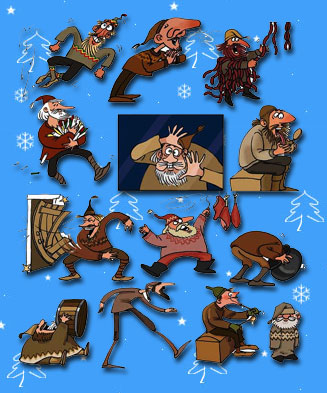|
Jólasveinar
The
Jólasveinar start arriving in town on the morning of December
12th. Remember to place a shoe on your virtual windowsill before
that, as they will leave a small cyber-gift for children who have
been good, a small toy or fruit, for example, and those children
who have been naughty will receive something they will not like
too much.
Every day from December 12th to Yule Eve, December 24th, a click
on the Drummer Boy will take you to today's Jólasveinn, but until
December 12th the Little Drummer Boy is enjoying a deserved rest.
Jólasveinar
first appeared in the 17th century as the sons of Grýla
and Leppalúđi, who themselves had appeared in the 13th
century and had earned a reputation for stealing and eating
naughty children.
The Jólasveinar
were tallied at either nine or thirteen, but their names are at
least 70.
Thirteen of
the most commonly accepted names of the Jólasveinar are:
A few of
the other names used for the Jólasveinar follow, along with
English translations. Their names are descriptive of their
natures.
Baggi
- Bundle
Bandaleysir - Strap Loosener
Bjálfansbarniđ - Idiot Child
Faldafeykir - Skirt Blower
Flotgleypir - Fat Gobbler
Hlöđustrangi - Barn Roll
Kleinusníkir - Donut Beggar
Lampaskuggi - Lamp Shadow
Móamangi - Moor Charlie
Reykjasvelgur - Smoke Gulper
Smjörhákur - Butter Greedy
Svartiljótur - Blackugly
Svellabrjótur - Icebreaker
As can be
seen from the names, the Jólasveinar are thought of as playful
imps whose main interest seems to be getting their hands on some
of the seasonal food and other goodies, or lurking about trying to
do some minor mischief.
When they
first appeared the Jólasveinar had many of the attributes of
their parents but soon started to seem milder. In the last century
they gained some of the attributes of their Nordic counterparts,
and in this century have become homegrown versions of St. Nick or
Santa Clauses.
The Jólasveinar
live in the mountains and start to arrive in town, one a day,
thirteen days before Christmas Eve with the last one arriving that
morning. They leave little presents for the children in shoes the
children have placed on the windowsill the night before. If the
children have been naughty, they leave a potato or some other
reminder that good behaviour is better. They start departing for
home again on Christmas Day, with the last one departing on Ţrettándinn.
At first
the clothing of the Jólasveinar was just the ordinary, every-day
wear of the common Icelander. In this century they have taken to
wearing the traditional red suits of St. Nick or Santa Claus. In
the last few years there has been a revival of the old style
clothing.
Grýla and
Leppalúđi
This pair
of child-eating, bloodthirsty ogres are the supposed parents of
the Jólasveinar. The dominant member in the relationship is Grýla,
who according to some sources had another husband before Leppalúđi.
His name was Boli. Boli, and later Leppalúđi, were bedridden and
Grýla went around the countryside begging to support her
husbands. At Christmas time she stole children who had been
naughty during the year. Through the centuries Grýla has been a
very popular means of making children behave. There are numerous
lays and stories about Grýla and her exploits, but she never
really gets her hands on the children. Either they have been very
well behaved throughout the year or they manage to escape.
|